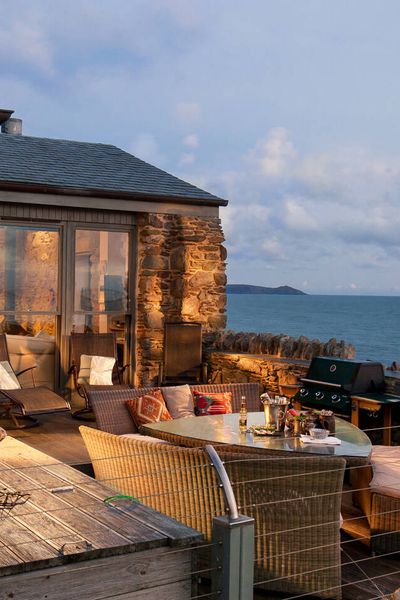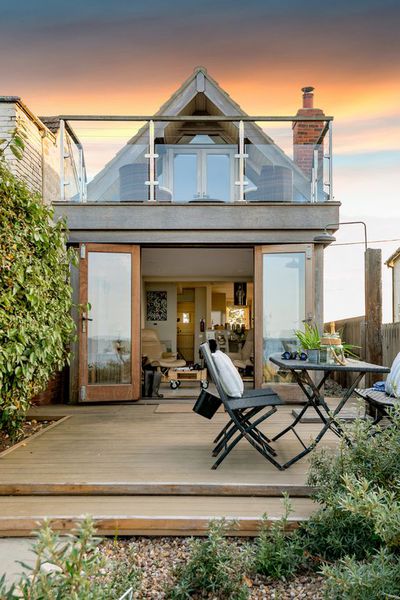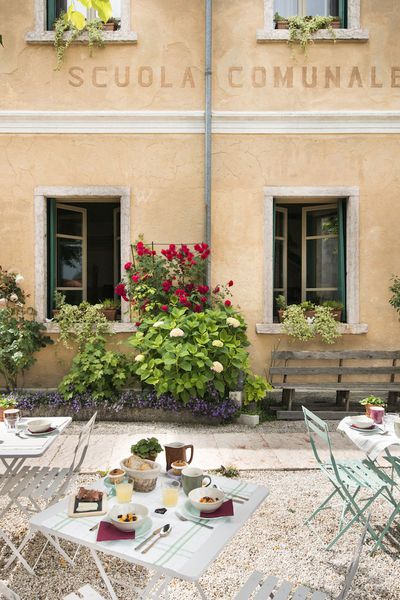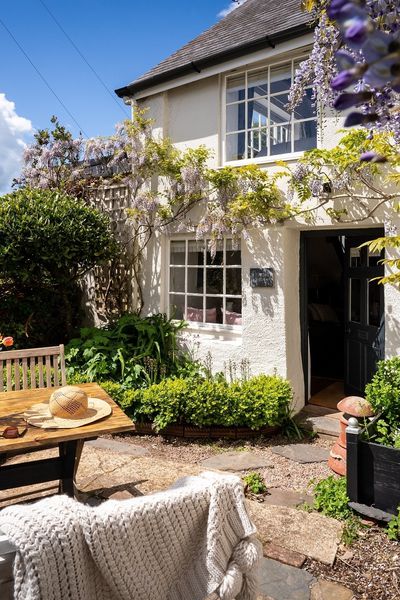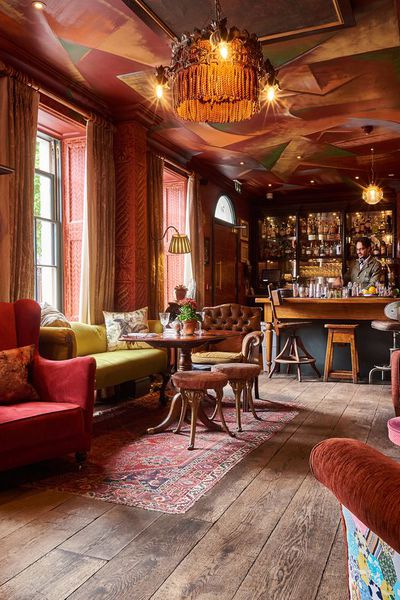Constantine Bay to St Mawgan

The North Cornish Coast is one of the most well-known in the whole UK. People flock there in the summer months, thronging the huge beaches with their dogs, families and surfboards in tow. While we love the likes of Watergate Bay – and the gorgeous hotel of the same name with its new Watchful Mary beach bar and Emily Scott restaurant – it’s the smaller, more secluded beaches and coves that always take our fancy. Constantine Bay lies on the Trevose Head Heritage Coast around three miles from Padstow and below Polzeath. Atop the beach cliffs, you’ll find a varied range of protected flora and wild fauna, with tidal rock pools down below and brilliant surfing in the rolling waves. This area of Cornwall is Camel Trail territory, and the 18-mile cycle route from Padstow takes you right into the heart of Bodmin Moor.
A day on the beach will leave you hungry, and south of Constantine Bay, just outside Mawgan Porth, lies the perfect answer to your post-swim appetite – Scot and Babs. The open-plan restaurant, named for the talented duo who run it from the barn at Retorrick Mill, serves up tasty treats cooked on open fires, spits and smoking slow roast barrels. Pizzas and wood-fired dishes are the norm, but there are fishy feasts, paella nights, steak and lobster evenings and music events scattered throughout the year, so their calendar is always worth a look. It’s rustic, quirky, eclectic and fun, tapping into the rougher, simpler side of Cornwall’s food and drink that most locals favour over the famous chefs and fine cuisine. If you’re inspired to source, as well as cook, then head for Padstow Kitchen Garden. It supplies some of the best restaurants in the country, even taking commissions to create veg of specific sizes. You can learn from the experts on courses that range from simple recipes to building your own propagator and getting to grips with the rhythms of seasonal planting.
Slow Guide to Cornwall Gallery 1

St Agnes and Porthtowan
Driving south along the coast, brought us to St Agnes – which some consider to be the very essence of rural Cornwall. This stretch of coastline is littered with relics from the historic mining industry and a walk along the coastal path from Perranporth will treat you with rugged caves, secret coves carved into tiny niches and the squat shapes of old military bunkers. Nothing beats watching sunset over Chapel Porth beach, next to the looming ruin of Wheal Cotes engine house. The town itself has an array of independent cafés, shops and pubs, and Wheal Kitty Workshop is a creative hub that’s home to innovative brands and organisations such as Finisterre and Surfers Against Sewage. As if there weren’t enough brilliant eateries around already, there’s a Canteen located in the workshop’s old tin mine that offers amazing locally sourced food and fresh-baked pastries every day.
Whether you’re here for a day or the whole week, make time for a plunge in the Porthtowan tidal pool just along the coast. Naturally it’s only accessible when the tide’s out, but you can work a dip into your day and head on west.
Slow Guide to Cornwall Gallery 2

Godrevy to Botallack
There’s no doubt St. Ives is a popular spot with its working harbour, TATE gallery, cobbled side streets and independent shops. However, if we’re to brave the crowds it’s to visit the Barbara Hepworth Sculpture Museum, which offers an insight into the work of one of Britain’s most important twentieth century artists. If you’re visiting, we’d recommend hopping on the short, rattling train from Carbis Bay as it offers ten minutes of serene coastal views. Nestled between St Ives and Godrevy Lighthouse is Gwithian Towans, where you’ll find three miles of sprawling white sands. The beach is so large it’s hard to feel overrun, and nothing tops a day off like watching a fiery orange sunset from the clifftop with lapping waves and surfers below.
Carry on past St. Ives and you arrive in Cornwall’s far west and at the start of one the region’s most epic hikes. The walk takes you through the remnants of a once great mining industry, starting from the Count House at Botallack and winding through the imposing granite buildings out onto the cliff path. As you climb into the hills, you find yourself in wildflower meadows, looking out at the towering cliffs and crumbling engine houses which play a rich part in Cornish culture and folklore.
Slow Guide to Cornwall Gallery 3

Fowey and Looe
This pocket of Cornwall is most renowned for the Eden Project, but there’s far more to see here beyond the iconic domes. Looe sits on this easterly coast, with the River Looe running in between two parts of the harbour town. A regular ferry, which takes around 20 minutes, shuttles you from the town to Looe Island – giving you a few hours either side of high tide to explore the the rock which is a nature reserve home to bird species and a colony of “hook-nosed sea pigs” more commonly known as grey seals. If this whets your appetite for exploring more of the area’s wild beauty, head north of Looe along the River Fowey where you will find Golitha Falls. Parking is at Draynes Bridge, then make the quarter-mile walk through ancient woodland to the series of tumbling cascades.
The South-West coastal path between Polperro and Polkerris offers an invigorating hike to Fowey with wild swimming spots en route. Voted one of the UK’s best wild swimming spots by The Times, Pokerris Cove is a great place for a dip and you’re perfectly situated to grab dinner at Sam’s. The cool seafood bar is right on the sand, making the perfect end to your day in and on the water. Nearby Fowey is a great combination of lively bustle and historic narrow backstreets, hiding eclectic antique shops and local art galleries. The town is great to wander through and there are plenty of cafes and pubs to tempt you into stopping for a while. From here, the Saint’s Way runs across the county to Padstow, but for something less challenging, hit the local coastal paths to Lantic Bay – a beautiful beach that’s covered in edible sea cabbage. To escape the hustle and bustle of summer crowds, we take the lesser-known woodland track from Coombe down to Polridmouth Cove, a totally secluded beach with fantastic views of rolling hills and Gribbin Head. If taking to the water is your thing, there’s ample places to hire kayaks or boats – make sure you keep an eye out for the resident dolphin that lives in the harbour!
Slow Guide to Cornwall Gallery 4

The Roseland Peninsula
South of Fowey you will find The Roseland Peninsula. While lesser known than some areas of the county, few places in Cornwall can rival it for beauty. One unmissable stop is The Lost Gardens of Heligan, which were abandoned at the outbreak of WW1 and painstakingly revived by Tim Smit and a dedicated team in the 90s. Today, the estate is blooming with over 200 acres of rare trees, plants, gardens and animals. We love getting lost in the bamboo jungles, walking over the rope bridges and discovering the iconic Heligan sculptures. This whole area is full of historic remains; including the Caerhays Castle estate (with Scottish highland cows) that overlooks Porthluney Bay. In summer months, the beach bar runs drive-in movies, live jazz music and pizza nights. The nearby Dodman’s Point is not only the highest headland in South Cornwall, it’s home to prehistoric cliff castles and wild horses. A circular walk from Hemmick Beach takes you up to the cliffs and alongside uninterrupted views of the English channel.
The whole region is brimming with secret beaches and hidden walking paths. Vault Beach is often quiet even in busy months due to its imposing descent – but you’ll be rewarded for your bravery with white sands, clear waters and shelter from winds. A drive further down the coast takes us to Porthcurnick Beach for sunset and brings us to the incredible setting of The Hidden Hut, which is about as far from uptight fine dining as you can get. It’s BYO everything, even chairs, with the venue providing tables and food. It sounds sparse, but when you’re eating fresh, perfectly-cooked seafood with the sound of the surf fizzing onto the beach as the sun goes down, you feel pretty well catered for. A few of our local owners tip us off on a few of the lesser-known beaches around St Mawes. In their words, “the perfect day starts with a walk along Summer’s Beach or the St Anthony’s Loop coastal path” and is finished with a fresh brew and homemade cake from Bear Van at St Mawes Castle. The latter route takes you past the headland and lighthouse, before scrambling down to Great Molunan beach. This is a phenomenal spot – relatively unknown still – and on warm, sunny days it really does feel like you could be in the Med. Other hidden spots include Porthbear Beach and Parc Caragloose Cove, both difficult to get to but very much worth the effort.
Slow Guide to Cornwall Gallery 5

Falmouth and its surrounds
The river Fal, which starts near St Austell and runs all the way to Pendennis Point outside Falmouth, has some of the most beautiful scenery and diverse communities in Cornwall. The town of Falmouth, on the South coast of the county, is worth visiting for its creative feel and maritime heritage. If you love food, the annual Oyster Festival in October is the perfect time to drop by and shuck a few. The festival marks the start of the oyster dredging season and celebrates Cornish seafood; you’re likely to find cooking demos from top chefs, delicious locally sourced dishes (not just oysters, if they aren’t your thing!), Cornish Ales and the festival’s house musicians, Betty Stoggs and her band. If your visit doesn’t tie in with the festival there are plenty of other top-class options for sampling seafood in the town, where the food scene is booming. The Wheelhouse, a tiny unassuming place on a side street by the quay, serves up some of the best local seafood, but be prepared to book months in advance! The Star & Garter on the high street is equally popular but worth a visit for its award-winning nose-to-tail menu.
A short drive from Falmouth is the lesser-known Trebah Gardens, a tropical paradise tucked away against a coastal backdrop. The beautiful 26 acre Cornish valley garden has over four miles of footpaths where you can explore canopies bursting with exotic blooms and vibrant tunnels of colour. In spring, the place comes alive with a colourful array of 100-year-old rhododendrons, magnolias and camellias. Whilst in autumn, Hydrangea Valley casts clouds of blue and white across Mallard Pond. Whatever time you decide to visit, make sure you go check out Polgwidden Cove – the private and secluded beach, which backs onto the Helford River.
If an afternoon’s walking has you hankering for a pint of Cornish cider, drive (about 20 mins) from Trebah to The Pandora Inn on Restronguet Creek; one of the prettiest places for a pint this side of the Tamar. The pretty thatched pub sits on the river, with a big jetty filled with picnic tables and a view of people paddling and crabbing in the water. Be warned; one pint easily turns into three here when the sun shines, and those apples make some strong stuff.
Slow Guide to Cornwall Gallery 6

Porthleven to Penzance
As with most of Cornwall, you’ll need a car to cover much ground, but exploring the 15-mile stretch of coastline from Porthleven to Penzance is a wonderful day’s drifting journey. Porthleven feels like a community fishing village, with its brilliant annual food festival alongside the just launched Arts Festival too. Walk into the village along the coastal path from Looe Bar for stunning views of the gnarly Cornish cliffs and stop at Origin Coffee to refuel before browsing the independent galleries, jewellers and art shops that line the harbour.
From Porthleven you can take the A394 towards Penzance, stopping off at the beaches along the way. Praa Sands is a wide sandy beach perfect for families, but try the more secluded bay of Prussia Cove a little further along down a single track road if you want something quieter. There are also lovely walks along this part of the coast if you have time, such as the route from Perranuthnoe to Cudden Point; around two miles of scenic trail along the clifftops. A busy day is always best finished with food, and locals love heading to New Yard Restaurant for innovative dining in a rustic alfresco setting.
As you head towards Penzance, make a stop in the picturesque fishing village of Newlyn just to the south. It’s a pleasant enough place, but there’s one very good reason to make the trip – Jelbert’s. The tiny ice cream shop is a local legend and you’ll know you’ve found it when you see the snaking queue outside. They only serve one flavour here (vanilla), but when you taste it you’ll know why! If you’re feeling peckish, Mackerel Sky serves seafood tapas-style in a tiny white-washed wooden cabin. It’s that good you’ll often find a queue outside, but we can confirm it’s well worth the wait.
From Newlyn, with your Jelbert’s in hand, you can walk along the prom into Penzance. The painters capturing the sea’s beauty along the way are your first taste of Penzance’s contemporary art scene and you can immerse yourself in it with visits to renowned galleries like Penlee House and the not-for-profit Redwing, which is run by volunteers and has a good vegetarian cafe. Wandering further down the prom takes you to Penzance’s Jubilee Pool; an art-deco lido with a newly opened Geothermal pool, the first of its kind in Europe. The pool was given a new lease of life after being damaged by storms in 2014; the community clubbed together to take over it’s running and refurbishment, keeping a seafront tradition alive with their passion and dedication.
Slow Guide to Cornwall Gallery 7

Mousehole to Lands End
The Cornish have a long tradition of song and theatre as well a great passion for the countryside. These are combined perfectly in the spectacular, open-air Minack theatre, carved into the cliffs above Porthcurno Beach, and a huge variety of nomadic, spontaneous and creative performance groups that bring cultural adventure to every corner of the county. Theatre companies like Kneehigh, Rogue and Miracle often perform in Cornwall and Carn to Cove, a volunteer group of performers, musicians and actors, stage all sorts of lively events in even the smallest villages.
Nothing lies between this most westerly English point and the US, so you can expect sensational views of the endless ocean. While we love beaches like Sennen and Porthgwarra, nothing beats the wild, secret cove of Nanjizal – home to the song of the sea, where wind and tides occasionally (very rarely) combine to “sing” through the narrow arch of Zawn Pyg. It’s truly secluded and often deserted, due to its distance from any road or car park. However it’s well worth making the effort to walk to, if only to check out the famous arch and Diamond Horse rock formation. Caves and rock pools emerge when the tide retreats, and there’s even a freshwater waterfall to wash off that salty swim.
Slow Guide to Cornwall Gallery 8
Where to stay…

Places to stay in Cornwall
Discover our collection of special places to stay in Cornwall, from grand country houses to idyllic seaside cottages and remote cabins.
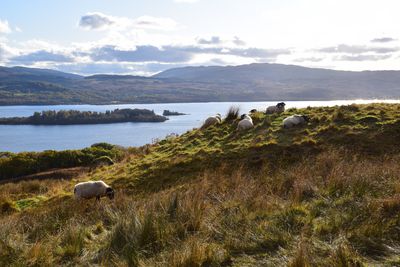
Our Slow Guides
View our other Slow Guides to UK destinations: including Devon, Dorset, Sussex, Lake District, Northumberland and Norfolk.
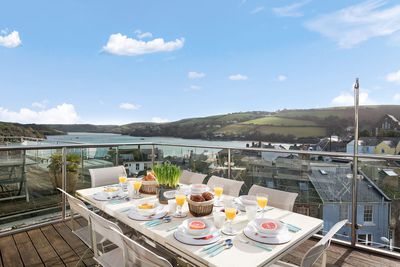
Coastal retreats
Find over 100 beautiful places to stay in the UK and Europe all within three miles of the coast.
